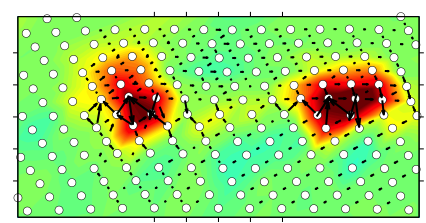Mg is among the lightest structural metals. Due to its hcp structure, however, it has high plastic anisotropy. That is, dislocations on different hcp slip systems have widely differing critical resolved shear stresses for dislocation motion. In addition, twinning is an important deformation mechanism in most Mg materials.
We have performed a number of studies of dislocation core structures using both multiscale DFT methods and atomistic methods, to understand structure and to validate interatomic potentials. We have recently developed a new interatomic potential for Mg that accurately predicts core structures for basal and prism <a>, Pyramidal I and II <c+a>, and twinning structures, with Peierls stresses in the range of experiments and also predicting good fracture properties.

We have applied our solute-strengthening model to predict basal slip strengthening in Mg-Al and Mg-Zn. Recently we have extended the model to understand solute strengthening of twinning dislocations in Mg-Al and Mg-Zn. In all cases, good agreement with experiments is achieved, although experiments themselves are contradictory in some cases.
We are also developing models for twin growth. We have recently shown that twin growth can occur by a nucleation and growth mechanism that is strongly facilitated by the presence of random solutes. At the same time, segregation of solutes strongly suppresses this growth mode. In unpublished work, we have also explained the origin of the lenticular shapes of twins in Mg.
Key publications:
- A. Luque, M. Ghazisaedi, and W. A. Curtin, “Solute-controlled Twin Growth and Pinning in Mg”, submitted to Acta Mater.
- M. Ghazisaeidi, L. G. Hector Jr., and W. A. Curtin, Solute strengthening of twinning in Mg, Acta Mater. (2014).
- Z. Wu and W. A. Curtin, “Mg interatomic potential for simulation of plasticity and fracture”, submitted MSMSE 2014.
- M. Ghazisaeidi and W. A. Curtin, <c+a> dislocation cores in Mg via First-Principles, Scripta Metallurgica (2014).
Additional work:
- M. Ghazisaedi and W. A. Curtin, Nucleation of Twinning in Mg, MSMSE (2013).
- A. Luque, M. Ghazisaedi, and W. A. Curtin, Deformation of Mg nanopillars, MSMSE (2013).
- J. A. Yasi, T. Nogaret*, D.R. Trinkle, and W. A. Curtin, “Basal and prism dislocation cores in magnesium: comparison of first-principles and embedded-atom-potential method predictions”, Mod. Sim. Matls. Sci. Eng. 17, #055012 (2009).
- T. Nogaret, J. A. Yasi, W. A. Curtin, and D.R. Trinkle, “<c>+<a> dislocation cores in magnesium: comparison of first-principles and embedded-atom-potential method predictions”, Acta Mater. 58, 4332-4343 (2010).